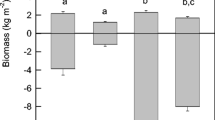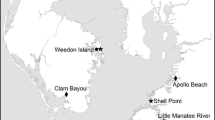Abstract
Two saltmarsh species, the native Arthrocnemum macrostachyum (AM) and the invasive Spartina densiflora (SD), were compared in terms of monthly variation of above and belowground biomass, and nutrient (N, P, K, Ca, Mg, Mn) concentrations, over 1 year, in Castro Marim saltmarsh, Portugal. Net aboveground primary productivity was also estimated by two different methods. Above and belowground biomass were higher in SD than in AM and there were distinct monthly variations in the two species. Maximum relative growth rate was observed in the October/January period for SD (4.92 ± 0.36 mg g-1 day-1) and in April/July for AM (3.37 ± 1.26 mg g-1 day-1). Whatever the method used, net aboveground primary productivity was higher in SD (2,603 and 2,923 g m-2 yr-1, respectively by the Smalley and the Wiegert and Evans method) than in AM (692 and 1,012 g m-2 yr-1, respectively). The turnover rate for aboveground live biomass of AM was half the value of SD (0.8 yr-1 and 1.7 yr-1, respectively). The N/P ratio in photosynthetic active components and belowground biomass of AM (11 and 13) was higher than in those of SD (7 and 10). Concentrations of K, Ca and Mg in photosynthetic tissues of SD were lower than in AM. Differences observed between study species suggest that S. densiflora has better ability to use resources and to compete with native species.




Similar content being viewed by others
References
An SQ, Gu BH, Zhou CF, Wang ZS, Deng ZF, Zhi YB, Li HL, Chen L, Yu DH, Liu YH (2007) Spartina invasion in China: implications for invasive species management and future research. Weed Res 47:183–191
Ayres DR, Smith DL, Zaremba K, Klohr S, Strong DR (2004) Spread of exotic cordgrasses and hybrids (Spartina sp.) in the tidal marshes of San Francisco Bay, California, USA. Biol Invasions 6:221–231
Baumel A, Ainouche ML, Misset MT, Gourret J-P, Bayer RJ (2003) Genetic evidence for hydridization between the native Spartina maritima and the introduced Spartina alterniflora (Poaceae) in south-west France: Spartina x neyrautii re-examined. Plant Syst Evol 237:87–97
Blumwald E (2000) Sodium transport and salt tolerance in plants. Curr Opin Cell Biol 12:431–434
Bortolus A (2006) The austral cordgrass Spartina densiflora Brong: its taxonomy, biogeography and natural history. J Biogeogr 33:158–168
Bouchard V, Lefeuvre JC (2000) Primary production and macro-detritus dynamics in a European salt marsh: carbon and nitrogen budgets. Aquat Bot 67:23–42
Bouchard V, Créach V, Lefeuvre JC, Bertru G, Mariotti A (1998) Fate of plant detritus in a European salt marsh dominated by Atriplex portulacoides (L.) Aellen. Hydrobiologia 373(374):75–87
Boyer KE, Fong P, Vance RR, Ambrose RF (2001) Salicornia virginica in a southern California salt marsh: seasonal patterns and nutrient-enrichment experiment. Wetlands 21:315–326
Callaway JC, Josselyn MN (1992) The introduction and spread of smooth cordgrass (Spartina alterniflora) in south San Francisco Bay. Estuaries 15:218–226
Castillo JM, Fernández-Baco L, Castellanos EM, Luque CJ, Figueroa ME, Davy AJ (2000) Lower limits of Spartina densiflora and S. maritima in a Mediterranean salt marsh determined by different ecophysiological tolerances. J Ecol 88:801–812
Castillo JM, Rubio-Casal AE, Redondo S, Álvarez-Lopez AA, Luque T, Luque C, Nieva FJ, Castellanos EM, Figueroa ME (2005) Short-term responses to salinity of an invasive cordgrass. Biol Invasions 7:29–35
Costa CSB, Peixoto AR (2004) Produção primária líquida aérea de Spartina densiflora Brong. (Poaceae) no estuário da laguna dos Patos, Rio Grande do Sul, Brasil. Iheringia. Série Botânica 59:27–34
Costa CSB, Marangoni JC, Azevedo AMG (2003) Plant zonation in irregularly flooded salt marshes: relative importance of stress tolerance and biological interactions. J Ecol 91:951–965
Cranford PJ, Gordon DC, Jarvis CM (1989) Measurement of Cordgrass, Spartina alterniflora, production in a macrotidal estuary, Bay of Fundy. Estuaries 12:27–34
Curcó A, Ibáñez C, Day JW, Prat N (2002) Net primary production and decomposition of salt marshes of the Ebre delta (Catalonia, Spain). Estuaries 25:309–324
Daehler CC, Strong DR (1994) Native plant biodiversity vs the introduced invaders: status of the conflict and future management options. In: Majumdar SK, Brenner FJ, Lovich JE, Schalles JF, Miller EW (eds) Biological diversity. Problems and challenges, Pennsylvania Academy of Science, Easton, PA, pp 92–113
Daehler CC, Strong DR (1996) Status, prediction and prevention of introduced cordgrass Spartina spp. Invasions in Pacific estuaries, USA. Biol Conserv 78:51–58
De Leeuw J, Olff H, Bakker JP (1990) Year-to-year variation in peak above-ground biomass of six salt-marsh angiosperm communities as related to rainfall deficit and inundation frequency. Aquat Bot 36:139–151
ERENA (2007) Plano de Ordenamento da Reserva Natural do Sapal de Castro Marim e Vila Real de Santo António, da Mata de Monte Gordo e dos Sapais do Beliche-Caroucha. ICN, Lisboa
Gallagher JL, Reimold RJ, Linthurst RA, Pfeiffer WJ (1980) Aerial production, mortality, and mineral accumulation-export dynamics in Spartina alterniflora and Juncus Roemerianus plant stands in a Georgia salt marsh. Ecology 6:303–312
Gorham J, Wyn Jones RG (1983) Solute distribution in Suaeda maritima. Planta 157:344–349
Gray AJ, Marshall DF, Raybould AF (1991) A century of evolution in Spartina anglica. Adv Ecol Res 21:1–62
Grevstad FS (2005) Simulating control strategies for a spatially structured weed invasion: Spartina alterniflora (Loisel) in Pacific Coast estuaries. Biol Invasions 7:665–677
Groenendijk AM (1984) Primary production of four dominant salt-marsh angiosperms in the SW Netherlands. Vegetatio 57:143–152
Gross MF, Hardisky MA, Klemas V (1990) Inter-annual spatial variability in the response of Spartina alterniflora biomass to amount of precipitation. J Coast Res 6:949–960
Gross MF, Hardisky MA, Wolf PL, Klemas V (1991) Relationship between aboveground and belowground biomass of Spartina alterniflora (Smooth Cordgrass). Estuaries 14:180–191
Hedge P, Kriwoken LK, Patten K (2003) A review of Spartina management in Washington State, USA. JAqua Plant Manag 41:82–90
Hopkinson CS, Gosselink JG, Parrondo RT (1980) Production of coastal Louisiana marsh plants calculated from phenometric techniques. Ecology 61:1091–1098
Hughes RG (2004) Climate change and loss of saltmarshes: consequences for birds. Ibis 146(suppl1):21–28
Ibàñez C, Day JW, Pont D (1999) Primary production and decomposition of wetlands of the Rhône Delta, France: interactive impacts of human modifications and relative sea level rise. J Coast Res 15:717–731
INAG (2001) Plano Nacional da Água. INAG—Instituto Nacional da Água, Lisboa
Khan MA, Ungar IA, Showalter AM (2000) Effects of salinity on growth, water relations and ion accumulation of the subtropical perennial halophyte. Atriplex griffithii var. stocksii. Ann Bot 85:225–232
Kittelson PM, Boyd MJ (1997) Mechanisms of expansion for an introduced species of cordgrass, Spartina densiflora, in Humboldt Bay, California. Estuaries 20:770–778
Kriwoken LK, Hedge P (2000) Exotic species and estuaries: managing Spartina anglica in Tasmania, Australia. Ocean Coast Manage 43:573–584
Lana PC, Guiss C, Disaró S (1991) Seasonal variation of biomass and production dynamics for above and belowground components of a Spartina alterniflora marsh in the euhaline sector of Paranagua Bay (Se Brazil). Estuar Coast Shelf Sci 32:231–241
Larcher W (1995) Physiological plant ecology, 3rd edn. Springer-Verlag, New York
Linthurst RA, Reimold RJ (1978) An evaluation of methods for estimating the net primary production of estuarine angiosperms. J Appl Ecol 15:919–931
Lousã MF (1986) Comunidades halofíticas da Reserva de Castro-Marim—Estudo fitossociológico e fitoecológico. Dissertation, Universidade Técnica de Lisboa
Mayor JR, Hicks CE (2009) Potential impacts of elevated CO2 on plant interactions, sustained growth, and carbon cycling in salt marsh ecosystems. In: Silliman BR, Grosholz ED, Bertness MD (eds) Human impacts on salt marshes. A global perspective, California University Press, Berkeley, pp 207–228
Mendelssohn IA, Morris JT (2000) Eco-physiological controls on the productivity of Spartina alterniflora Loisel. In: Weinstein MP, Kreeger DA (eds) Concepts and controversies in tidal marsh ecology. Kluwer Academic, New York, pp 59–80
Minchinton TE, Bertness MD (2003) Disturbance-mediated competition and the spread of Phragmites australis in a coastal marsh. Ecol Appl 13:1400–1416
Neira C, Levin LA, Grosholz ED, Mendoza G (2007) Influence of invasive Spartina growth stages on associated macroafunal communities. Biol Invasions 9:975–993
Neves JP, Ferreira LF, Simões MP, Gazarini LC (2007) Primary production and nutrient content in two salt marsh species, Atriplex portulacoides L. and Limoniastrum monopetalum L., in Southern Portugal. Estuaries and Coasts 30:459–468
Nieva FJ (1996) Aspectos ecologicos en Spartina densiflora Brongn. Dissertation, Universidad de Sevilla
Nieva FJJ, Castellanos EM, Figueroa ME, Gil F (1999) Gas exchange and chlorophyll fluorescence of C3 and C4 saltmarsh species. Photosynthetica 36:397–406
Nieva FJJ, Díaz-Espejo A, Castellanos EM, Figueroa ME (2001) Field variability of invading populations of Spartina densiflora Brong. in different habitats of the Odiel Marshes (SW Spain). Estuarine. Coastal and Shelf Sci 52:515–527
Nieva FJJ, Castillo JM, Luque CJ, Figueroa ME (2003) Ecophysiology of tidal and non-tidal populations of the invading cordgrass Spartina densiflora: seasonal and diurnal patterns in a Mediterranean climate. Estuar Coast Shelf Sci 57:919–928
Pennings SC, Callaway RM (1992) Salt marsh plant zonation: the relative importance of competition and physical factors. Ecology 73:681–690
Pont D, Day JW, Hensel P, Franquet E, Torre F, Rioual P, Ibañez C, Coulet E (2002) Response scenarios for the deltaic plain of the Rhone in the face of an acceleration in the rate of sea-level rise with special attention to Salicornia-type environments. Estuaries 25:337–358
Qadir M, Schubert S (2002) Degradation processes and nutrient constrains in sodic soils. Land Degrad Dev 13:275–294
Ranwell DS (1967) World resources of Spartina townsendii (sensu lato) and economic use of Spartina marshland. J Appl Ecol 4:239–256
Rosso PH, Ustin SL, Hastings A (2006) Use of lidar to study changes associated with Spartina invasion in San Francisco Bay marshes. Rem Sens Environ 100:295–306
Rozema J, Luppes E, Broekman R (1985) Differential response of salt-marsh species to variation of iron and manganese. Vegatatio 62:293–301
Scarton F, Day JW, Rismondo A (1999) Above and belowground production of Phragmites australis in the Po Delta, Italy. Bolletino del Museo Civico Storia Naturale di Venezia 49:213–222
Scarton F, Day JW, Rismondo A (2002) Primary production and decomposition of Sarcocornia fruticosa (L.) Scott and Phragmites australis Trin. ex Steudel in the Po Delta, Italy. Estuaries 25:325–336
Teal JM, Howes BL (2000) Salt marsh values; retrospection from the end of the century. In: Weinstein MP, Kreeger DA (eds) Concepts and controversies in tidal marsh ecology. Kluwer Academic, New York, pp 9–19
Wang Q, An SQ, Ma ZJ, Zhao B, Chen JK, Li B (2006) Invasive Spartina alterniflora: biology, ecology and management. Acta Phytotaxonomica Sinica 44:559–588
Wiegert RG, Evans FC (1964) Primary production and the disappearance of dead vegetation in an old field in southeastern Michigan. Ecology 45:49–63
Acknowledgements
This study was supported by grants of the project “Estudo das condições ambientais do estuário do Rio Guadiana e zonas adjacentes”, coordinated by the Instituto Nacional da Água/Laboratório Nacional de Engenharia Civil. We also thank A. Bettencourt, coordinator of this project in the Universidade de Évora, and the Laboratório de Botânica/ICAM. The staff of Laboratory of Soils of the Departamento de Ciências do Ambiente (Instituto Superior de Agronomia) is acknowledged for chemical analysis.
Author information
Authors and Affiliations
Corresponding author
Rights and permissions
About this article
Cite this article
Neves, J.P., Simões, M.P., Ferreira, L.F. et al. Comparison of Biomass and Nutrient Dynamics Between an Invasive and a Native Species in a Mediterranean Saltmarsh. Wetlands 30, 817–826 (2010). https://doi.org/10.1007/s13157-010-0080-4
Received:
Accepted:
Published:
Issue Date:
DOI: https://doi.org/10.1007/s13157-010-0080-4




